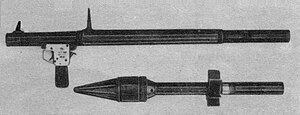RPG-2
| RPG-2 | |
|---|---|

RPG-2 antitank grenade launcher with PG-2 grenade
|
|
| Type | Recoilless rifle |
| Place of origin | Soviet Union |
| Service history | |
| In service | 1949–1960 (Soviet Union) |
| Used by | See Users |
| Wars |
Vietnam War Laotian Civil War Cambodian Civil War Rhodesian Bush War Cambodian-Vietnamese War Sino-Vietnamese War Thai–Laotian Border War Somali Civil War Yugoslav Wars 2008 Cambodian-Thai stand-off 2010–12 Burma border clashes Libyan Civil War Syrian Civil War |
| Production history | |
| Manufacturer | State Factories |
| Variants | M57 (Socialist Federal Republic of Yugoslavia) B-40 and B-50 (Vietnam), (Cambodia) PG-7 (Egypt) Type 56 RPG (China) |
| Specifications | |
| Weight | 2.83 kg (6.24 lb) (unarmed) 4.67 kg (10.30 lb) (ready to fire) |
| Length | 1,200 mm (47.2 in) |
| Crew | 2 including: Grenadier (carries the launcher with three grenades in special backpack) Assistant (armed with assault rifle and carries three more grenades) |
|
|
|
| Shell | PG-2 HEAT round |
| Caliber | 40 mm barrel 82mm warhead |
| Rate of fire | 3–4 rounds per minute |
| Effective firing range | 100–150 m |
| Maximum firing range | 200 m |
The RPG-2 (Russian: РПГ-2, Ручной противотанковый гранатомёт, Ruchnoy Protivotankovy Granatomyot; English: "hand-held antitank grenade launcher") was a man-portable, shoulder-fired anti-tank weapon designed in the Soviet Union. It was the first successful anti-tank weapon of its type, a response to the earlier and unsuccessful RPG-1. The RPG-2 offered better range and armor penetration, making it useful against late and post-World War II tanks where the RPG-1 was of marginal use. The basic design and layout was further upgraded to produce the ubiquitous RPG-7.
Studying German and US anti-tank rocket designs, in 1944 the Soviets began development of the RPG-1 with the goal of combining the best features of the German Panzerfaust with the US Bazooka. Propelled by a 30 mm cartridge, the 70 millimetres (2.8 in) HEAT round could penetrate about 150 millimetres (5.9 in) of homogeneous armor.
Early testing displayed a number of minor problems, but by the time these were being solved the 150 mm of penetration was considered to no longer be effective against modern tanks, even late-war designs like the Panther. The warhead was already straining the capabilities of the cartridge and its range was already considered too low. Modifications to improve this began, but in 1947 the RPG-2 program started as a parallel project. Development of the RPG-2 was carried out by the GSKB-30 design bureau, originally part of the Commissariat for Munitions, but in the post-war period handed to the Ministry of Agriculture to help design farm equipment.
The main difference in performance between the two were due to size. The RPG-2 used a custom designed 40 millimetres (1.6 in) cartridge to provide much greater power, and the warhead enlarged to 80 millimetres (3.1 in). This improved penetration to 180 millimetres (7.1 in) which allowed it to penetrate the frontal armor of all but very heaviest tanks, and the side and rear armor of any tank. The larger cartridge gave the PG-2 warhead slightly better practical range as well, about 150 metres (490 ft) against stationary targets.
...
Wikipedia
